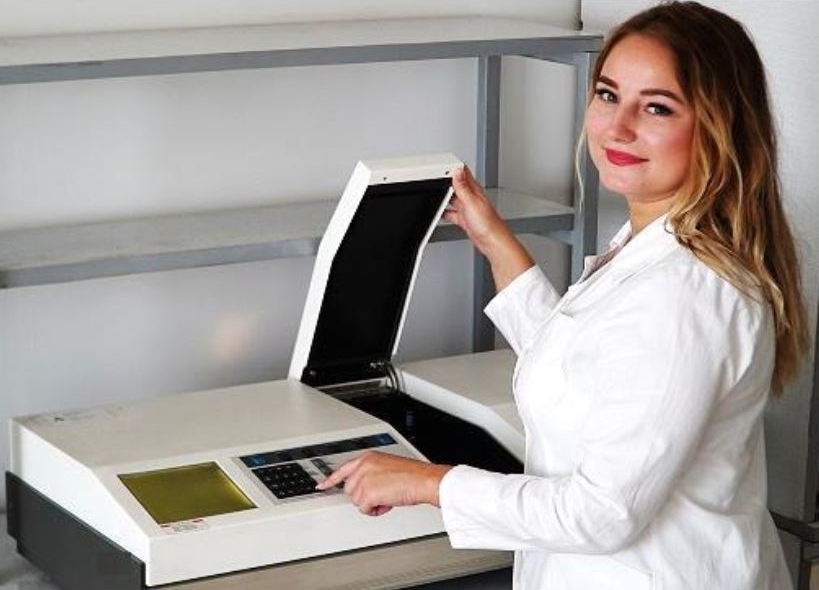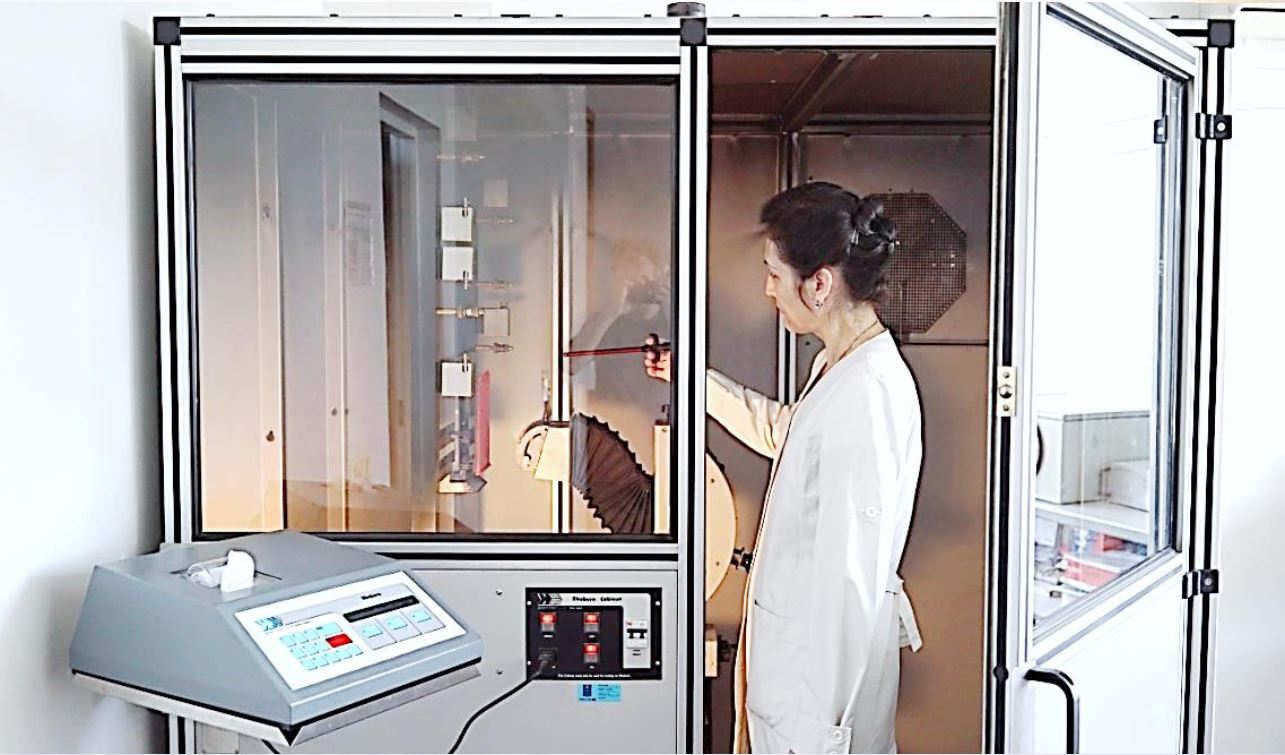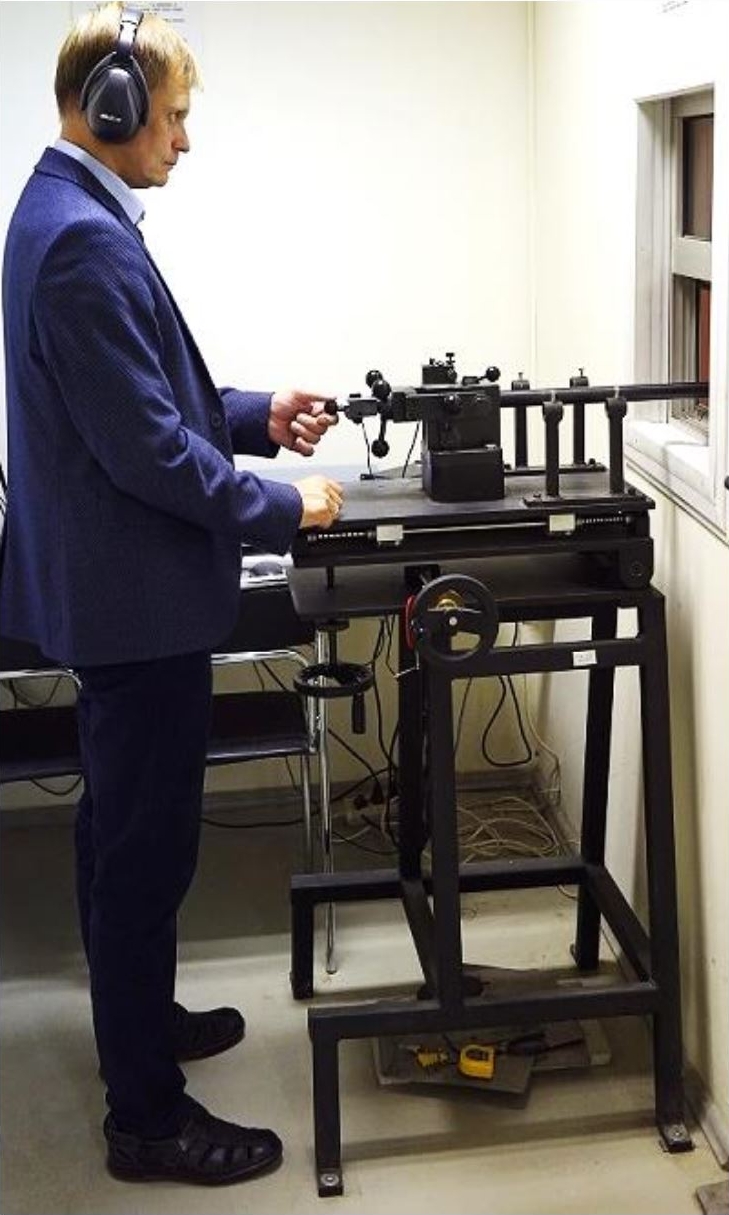Innovations
- Home
- Innovations
- Services
- Textile Testing
Services
-
Services
- Chemical and Phase Composition Studies, Electron Microscopy
- Accredited Corrosion Research
- Optical Measurements and Investigations
- Electromagnetic Compatibility Testing
- Tribology Testing
- Organic Chemistry Analysis
- Sample Age Determination
- Textile Testing
- Magnetic Validation
- Electrical Fault Studies
- Battery Studies
- Plasmonic Drug Testing
- Precise Processing
- Semiconductor Formation and Integration
- Custom Organic Synthesis
- Specialized Textile Manufacturing
- Optical Coatings
- Environmental Studies
- Services offered by the National Metrology Institute
- Accredited Services and Metrology
- Technology Transfer & Networking
- Contact Us
Investigations by the Textile Division of the FTMC



Qualitative and quantitative fiber composition (for all textile materials and all forms)
- Melting temperature determination (according to ISO / TR 11827, page 7.6.2 (DSC test)).
- Qualitative analysis of polymers (according to STP-7 (DSC study)).
- Qualitative analysis of textile fibers (according to ISO / TR 11827, pp. 7.1.1, 7.2.1, 7.4 *).
- Qualitative and quantitative fiber composition of 2-fiber blends ( EN ISO 1833 series standards: EN ISO 1833-1, 4, 7, 11, 12 accredited) *. They are also available under Regulation (EU) No 182/2011 of the European Parliament and of the Council. Part 1 (accredited methods: mechanical separation, methods 8, 1, 11, 14) *.
- Qualitative and quantitative fiber composition of 3-fiber blends (according to EN ISO 1833-2 *). They are also available under Regulation (EU) No 182/2011 of the European Parliament and of the Council. 1007/2011 Part 1 Part 2 *.
- Qualitative and quantitative fiber composition of 4 fiber blends (according to STP-3).
- Qualitative and quantitative fiber composition (based on STP-4) of blends of 5 or more fibers.
- Qualitative and quantitative fiber composition (according to STP-22) of mixtures of natural fibers that are mechanically and chemically inseparable.
- Qualitative microscopic analysis of animal fibers (according to EN ISO 17751-1 and EN ISO 17751-2).
Determination of color fastness (for all types and all forms of textiles)
- Color fastness to artificial light (according to EN ISO 105 – B02 *) Irradiation up to 5 points and irradiation above 5 points.
- Color fastness to water (according to EN ISO 105-E01 *).
- Color fastness to sea water (according to EN ISO 105-E02).
- Color fastness to chlorinated water (according to EN ISO 105-E03).
- Color fast to sweat (according to EN ISO 105-E04 *).
- Color fastness to water drops (according to EN ISO 105-E07).
- Color fastness to abrasion (according to EN ISO 105-X12 *).
- Color fastness to dry cleaning (according to EN ISO 105 – D01 *).
- Resistance to friction with organic solvents (according to EN ISO 105-D02).
- Color fastness to washing (according to EN ISO 105 - C10, EN ISO 105 - C06 * and EN ISO 105 - C08).
- Color fastness to industrial washing (according to EN ISO 105-C12).
- Color fastness to ironing (according to EN ISO 105-X11).
- Color fastness to hypochlorite bleaching (according to EN 20105-N01).
- Stain resistance to organic solvents (according to EN ISO 105-X05).
Note on Tint Resistance Tests: Stain resistance may be assessed by agreement with the customer visually according to EN 20105-A02 and EN 20105-A03or instrumental EN ISO 105-A04 and EN ISO 105-A05.
Chemical testing (for all types and all forms of textiles)
- pH value (according to EN ISO 3071 *).
- Free formaldehyde content (aqueous extraction method) (according to EN ISO 14184-1).
- Quantification of non-fibrous matter (oils, fats, paraffin, etc.) (according to STP-5).
Physical tests (for fabrics, knitwear, nonwovens)
- Surface Density:
- for various materials (according to EN 12127 *);
- for fabrics only (according to ISO 3801, p. 5 *);
- for nonwovens (according to EN 29073-1);
- For rubber and plastic coated materials (according to EN ISO 2286-2).
- for various materials (according to EN ISO 13934-1 * (strip method));
- for various materials (according to EN ISO 13934-2 (rag method));
- for coated materials (according to EN ISO 1421 *);
- for nonwovens (according to EN 29073-3).
- for fabrics, nonwovens (according to EN ISO 13937-1 (Elmendorf method), EN ISO 13937-2 * (trouser shape) EN ISO 13937-3 (wing shape), EN ISO 13937-4 ( tongue shape) and EN 1875-3 (trapezoidal shape);
- non-woven fabrics coated (according to EN ISO 9073-4: 2000);
- for coated materials (according to EN ISO 4674-1 *).
- for various materials (according to EN ISO 12947-2 * (before specimen decomposition));
- for various materials (according to EN ISO 12947-3 (Determination of mass loss));
- for various materials (according to EN ISO 12947-4 (change of appearance assessment));
- for coated materials (according to EN ISO 5470-2);
- for furniture (according to EN 14465, Annex A);
- For socks (according to EN 13770).
- for coated materials (according to EN ISO 7854).
- Fabric longitudinal density (according to ISO 3801, Methods 1 ÷ 4).
- Determination of tissue width and length (according to ISO 22198).
- Length and width of textiles (according to EN 1773).
- Breaking properties (maximum force and elongation):
- Seam strength (according to EN ISO 13935-1 (strip method) and EN ISO 13935-2 * (strip method)).
- Tear force:
- Punching strength (according to EN ISO 13938-1).
- Material tendency to pile and bud (according to EN ISO 12945-2 (Martindale method)).
- Resistance to budding and puffing (according to EN ISO 12945-1 (Peeling box method)).
- Resistance to abrasion:
- Elasticity of materials (according to EN 14704-1 (Tensioning method)).
- Slip resistance of fabric threads (according to EN ISO 13936-1 (defined seam opening) and EN ISO 13936-2 (determined load)).
- Wrinkle smoothing (roughness) EN 22313).
- Material Resistance to Folding (Folding Procedure Only):
- Adhesive force (according to EN ISO 2411).
Physical tests (for yarn, fiber)
- Tear properties of yarn (according to EN ISO 2062).
- Thread twist (according to EN ISO 2061).
- Thread Density:
- of fabrics (according to EN 1049-2);
- knitwear (according to EN 14971).
- Thread length:
- from packaging (according to EN ISO 2060);
- of fabrics (according to ISO 7211-5);
- from knitwear (according to EN 14970).
- Fiber diameter (microscopic examination):
- for wool fibers (according to EN ISO 137 (microscopic examination));
- for man-made fibers (according to AATCC Test Method 20A, p. 14 (microscopic examination)).
Features related to physiological comfort
- Hygroscopicity (according to STP-8).
- Absorption (according to ISO 18696).
- Duration of absorption for towels (according to EN 14697, Annex B).
- Surface wobble resistance (according to EN ISO 4920).
- Resistance to water penetration:
- for various materials (according to EN ISO 811 *);
- for coated materials (according to ISO 1420).
- Water repellency of materials (according to EN 29865 (Bundesman rain test)).
- Air permeability (according to EN ISO 9237 *).
- Thermal resistance (according to EN ISO 11092 *).
- Steam resistance (according to EN ISO 11092).
- Water vapor permeability (cup method) (according to STP-1).
- Moisture transport properties (according to AATCC 195).
Dimensional stability
- Dimensional change after washing and drying (after 1 wash cycle) (according to EN ISO 5077 * (Washing and drying procedures - according to EN ISO 6330 *)).
- Product appearance evaluation after 1 wash (according to STP-2 (Washing and drying procedures - according to EN ISO 6330: 2012 *), Rating - by agreement.
- Bias after 1 wash:
- for knitwear (according to ISO 16322-1);
- for materials (according to ISO 16322-2);
- for products (according to ISO 16322-3).
- Washing and Drying Procedure (Separate or Optional):
- 1 cycle (according to EN ISO 6330 *);
- 2 ÷ 3 cycles (according to EN ISO 6330 *);
- 4 ÷ 5 cycles (according to EN ISO 6330 *);
- 10 ÷ 15 cycles (according to EN ISO 6330 *);
- 20 ÷ 25 cycles (according to EN ISO 6330 *);
- 30 cycles (according to EN ISO 6330 *);
- 50 cycles (according to EN ISO 6330 *).
Flammability properties, heat resistance
- Flammability of children's nightwear (according to EN 14878).
- Setting the ignition rate (without treatment) (according to EN ISO 6940).
- Ignition setting (low flame) (no treatment):
- curtains and uphoery (according to EN 1101).
- Flame spread detection (no treatment):
- curtains and uphoery (according to EN 1102).
- Limited flame spread:
- protective clothing (according to EN ISO 15025 *);
- For multilayer packages (according to EN ISO 15025 *);
- For accessories (according to EN ISO 15025 *).
- Determination of the flammability of garments (without treatment) (according to EN 1103).
- Flame spread properties (without treatment) (according to EN ISO 6941).
- Heat resistance (without treatment):
- for materials (according to ISO 17493);
- for accessories (according to ISO 17493).
Electrostatic properties of protective clothing
- Specific surface resistance (without treatment) (according to EN 1149-1 *).
- Perpendicular resistance (no machining) (according to EN 1149-2).
- Shielding factor and half-life (without treatment) (according to EN 1149-3, method 2).
Measurement of surface color
- Surface color measurement: CIE color coordinates, CIE 3D color coordinates, Color space variables (according to EN ISO 105-J01 *).
- Determination of color differences (ΔECMC, ΔE * ab) (according to EN ISO 105-J03 *).
- Characteristics of fluorescent materials (for highly visible protective clothing):
- CIE color coordinates x, y; Luminance factor (according to CIE 15 ( EN ISO 105-J01 *);
- Irradiation (according to EN ISO 20471: 2013, p. 5.2) (in accordance with EN ISO 105-B02 *).
- Spectral reflectance R in the near IR range (according to STP-21).
- Degree of whiteness (according to EN ISO 105 – J02).
Other tests
- Oil repellent only for flat materials (according to EN ISO 14419).
- UV protection factor (UPF) (according to EN 13758-1 + A1).
- Determination of material thickness (according to EN ISO 5084).
- Determination of Ballistic Resistance of Personal Body Armor (bullet proof vest, ballistic panels, plates) NIJ Standard – 0101.04.
NOTES:
1) "*" means studies included in the scope of accreditation.
2) "STP" means a test method developed in house.
Scope of conformity assessment of protective clothing
|
Type of protective clothing |
Standard applied |
|
Well-visible outfit |
EN ISO 20471 |
|
Protective clothing, worn during welding and similar processes |
EN ISO 11611 |
|
Protective clothing, against heat and flames |
EN ISO 11612 |
|
Protective clothing against dissipative electrostatic load |
EN 1149-5 |
|
Protective clothing against rain |
EN 343 |
Contact us
Contact us by filling out the inquiry form. We will respond within 2 business days.
Karolis Stašys
Innovation Manager / Inovacijų vadybininkas
Tel.: +370 629 85166
El.p.: karolis.stasys@ftmc.lt
